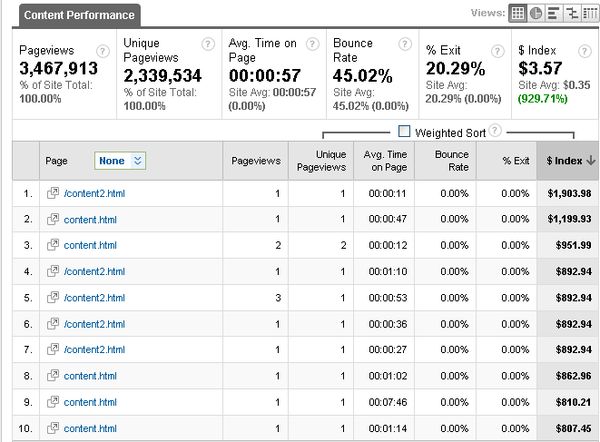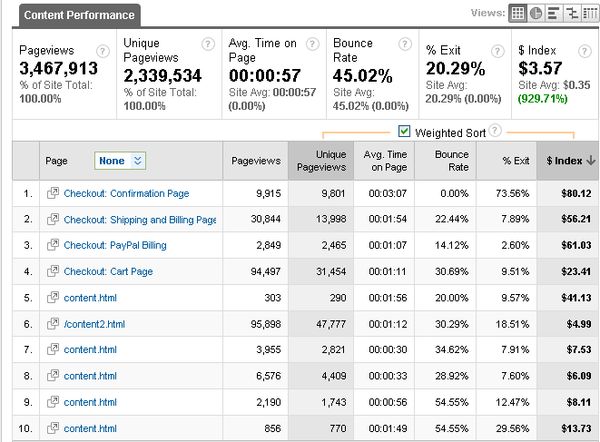Weighted sort in Google Analytics
Weighted Sort has got to be one of my favorite new features in Google Analytics. There is a nice demo for using weighted sort with bounce rate, but I thought I’d suggest another metric on which to use this new ranking algorithm.
Let’s start by asking a simple question:
What are my most valuable pages? #
As a proxy for “valuable”, we’ll use the $ Index metric in the Google Analytics Top Content report. $ Index measures the e-commerce revenue divided by the number of pageviews. The problem with sorting by $ Index is that you’ll see very large $ Index values because the pages only have one or very few pageviews.
In other words, the top page only had **one **measly pageview out of 3.5 million and it happened to have been during a visit that resulted in **one **sale. Not exactly optimization material, so let’s try and find pages that are doing a bit more work by using weighted sort. Just click and look at the results:
Don’t you just love it when the data you look at tells a great story**?** The first few results are all checkout pages, and this of course makes perfect sense as every visitor has to go through the checkout to place an order.
But now we can go down the list and look at other pages and get a sense of their true importance. Note the relationship between pageviews and $ Index: low pageviews and high $ Index being equivalent to high pageviews and low $ Index.
What weighted sort does beautifully is put data into context. You see, I don’t care about $ Index or Bounce Rate or e-commerce conversion rate per se, I am more interested in the** impact on business** and **prioritizing **my optimization efforts.
So a logical follow-up question to the first one might be:
Which page should I optimize? #
The one with a bounce rate of 60% or the one with 50%? The answer of course is:** it depends**. If both landing pages have the same amount of traffic I’d pick the one with 60%. However, if landing page A has a bounce rate of 60% and 1,000 views and landing page B has a bounce rate of 50% and 10,000 views, the impact of reducing the bounce rate of B will be higher even though its bounce rate is already better than landing page A.
I really appreciate the fact that weighted sort bubbles up this valuable data with a simple click, unlike some other approaches. And once you know your most valuables pages, guess which pages make great candidates for AB or Multivariate experiments?
The only downside of weighted sort is that you don’t know it exists unless you sort in the first place. A visual cue might be nice to indicate whether a column is weight-sortable, but I definitely know where to look for it and I hope you do too.

